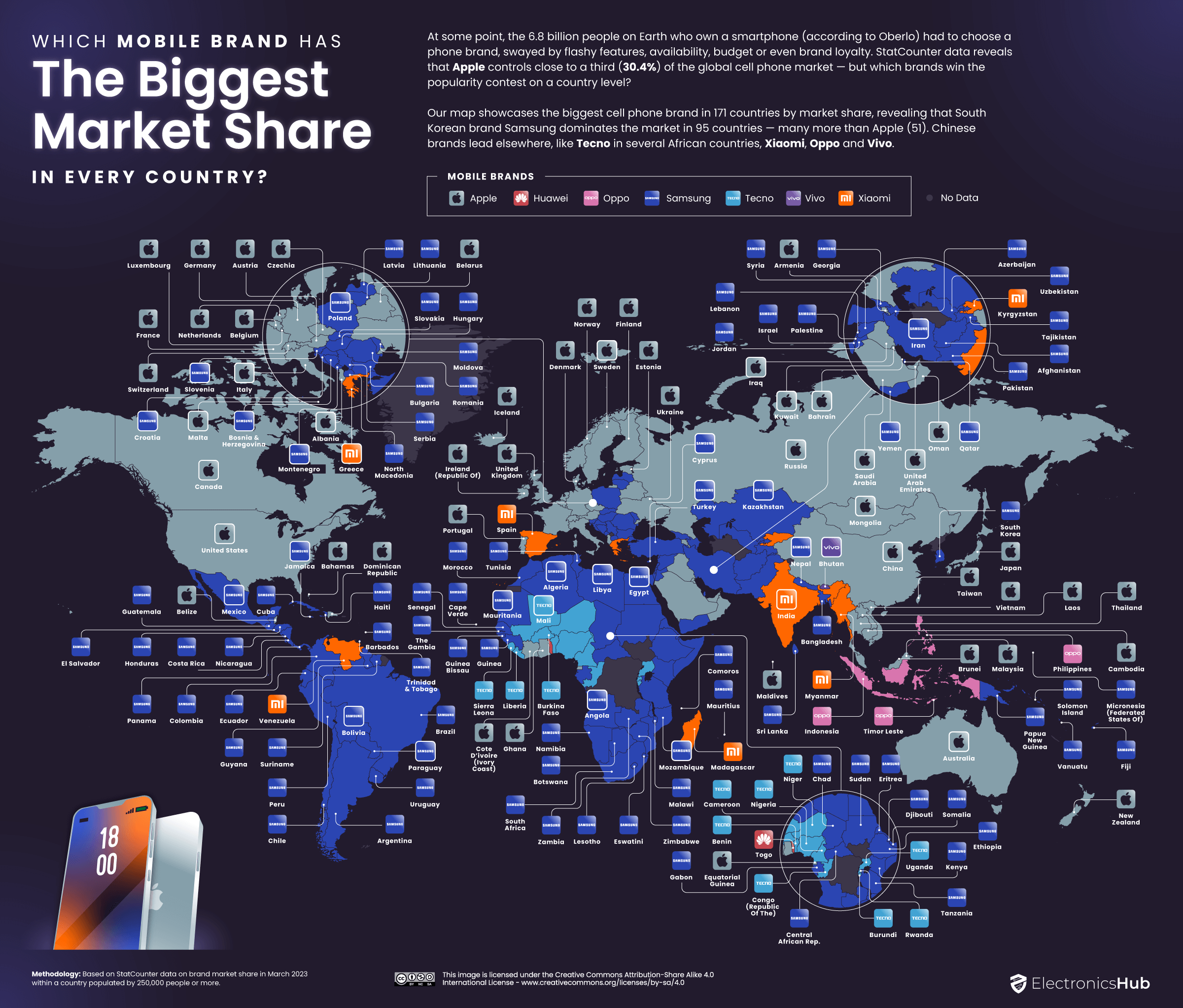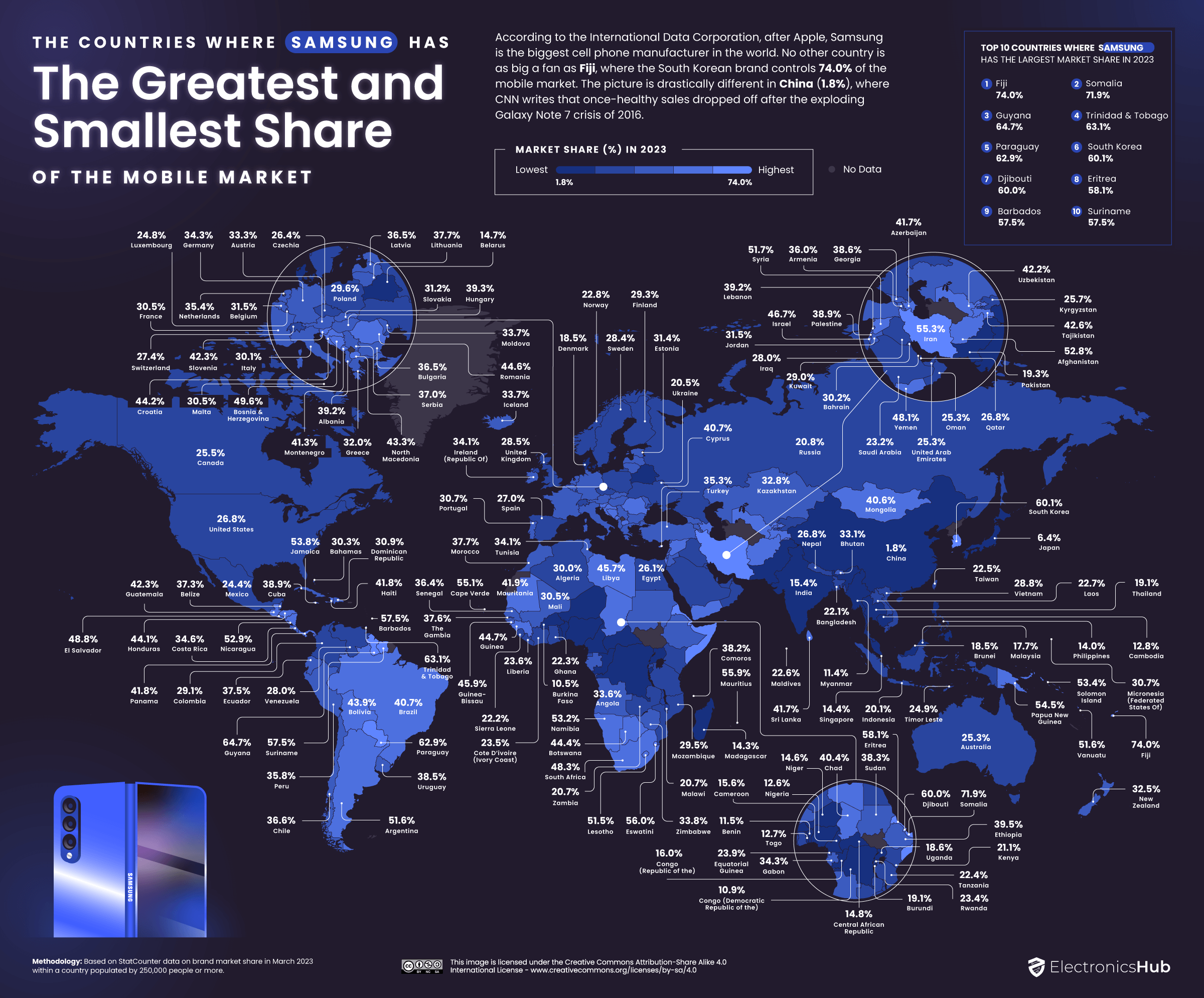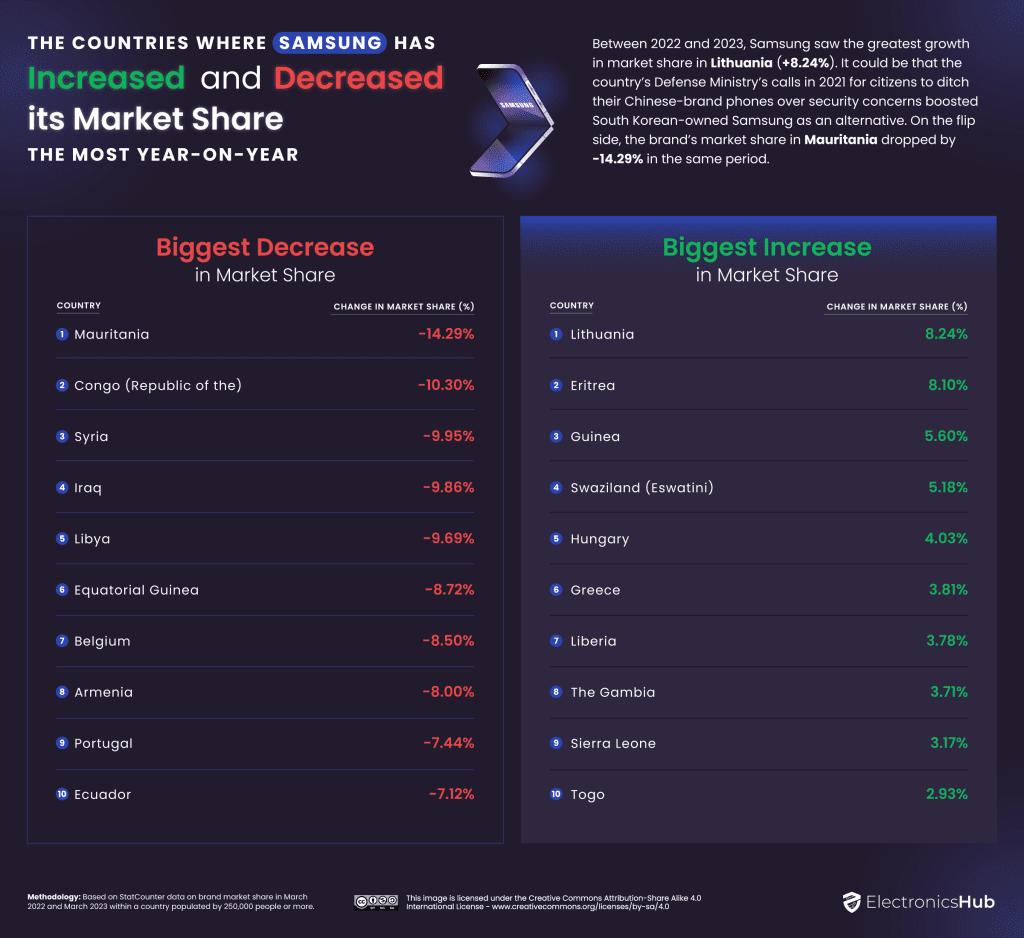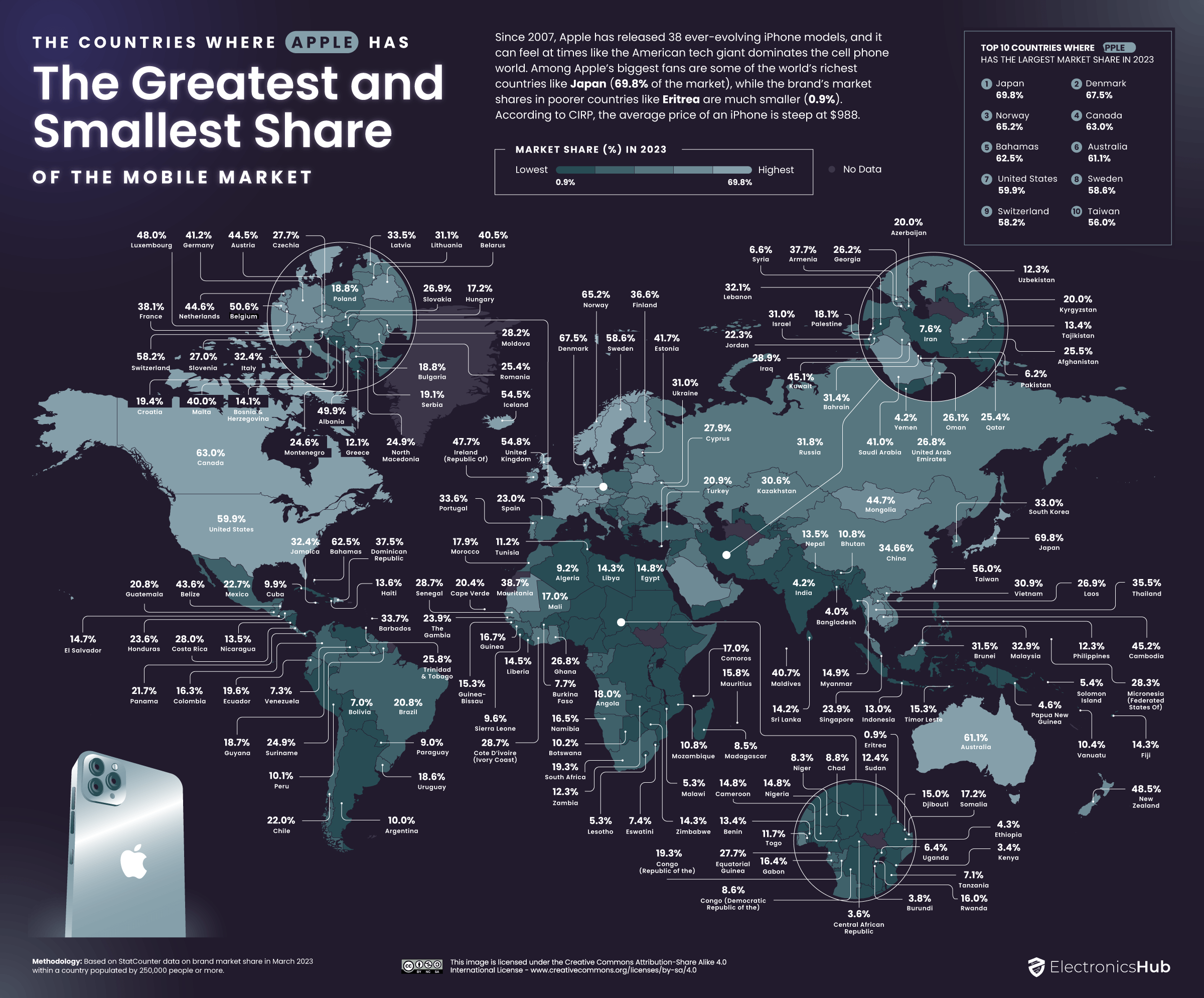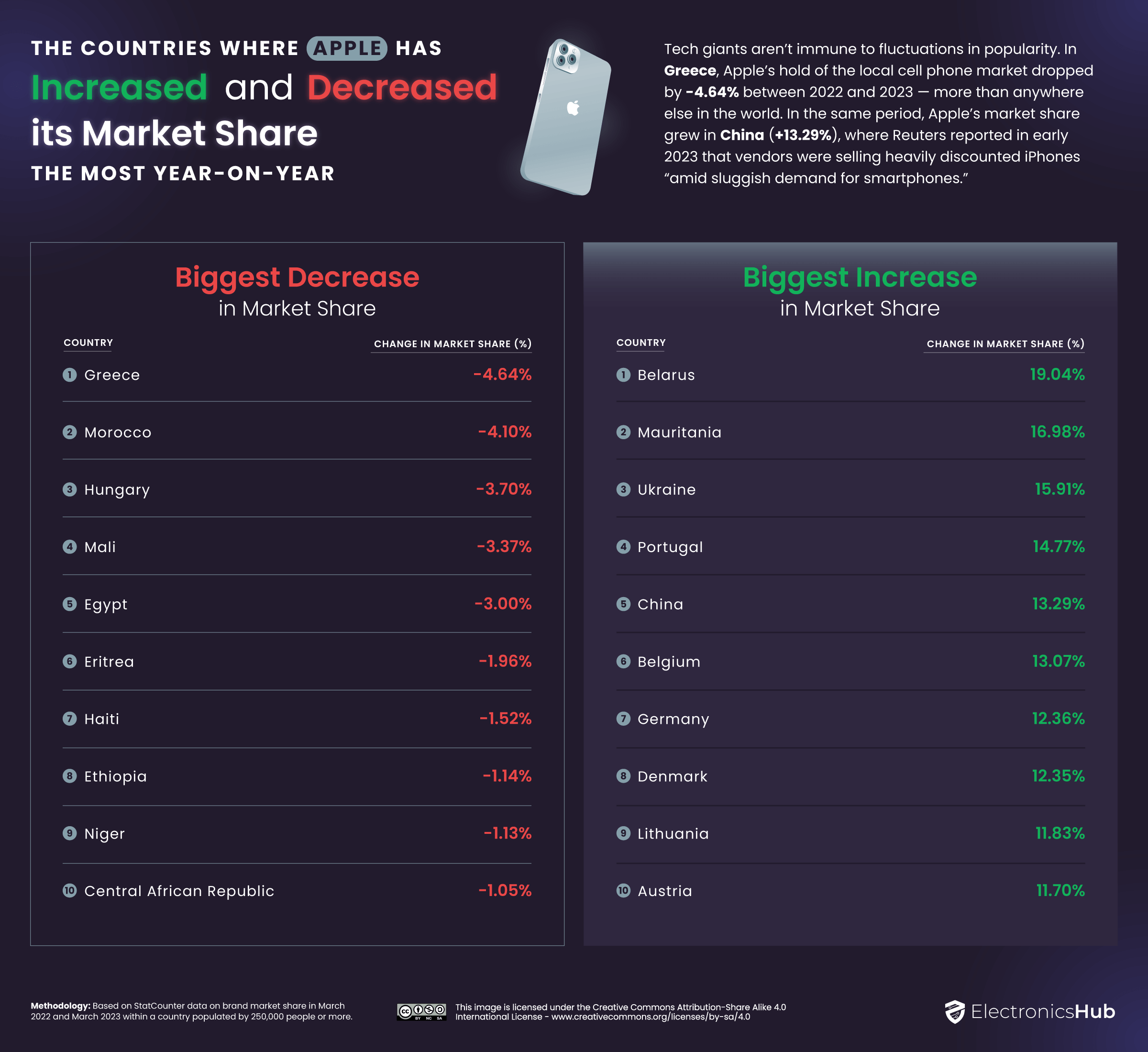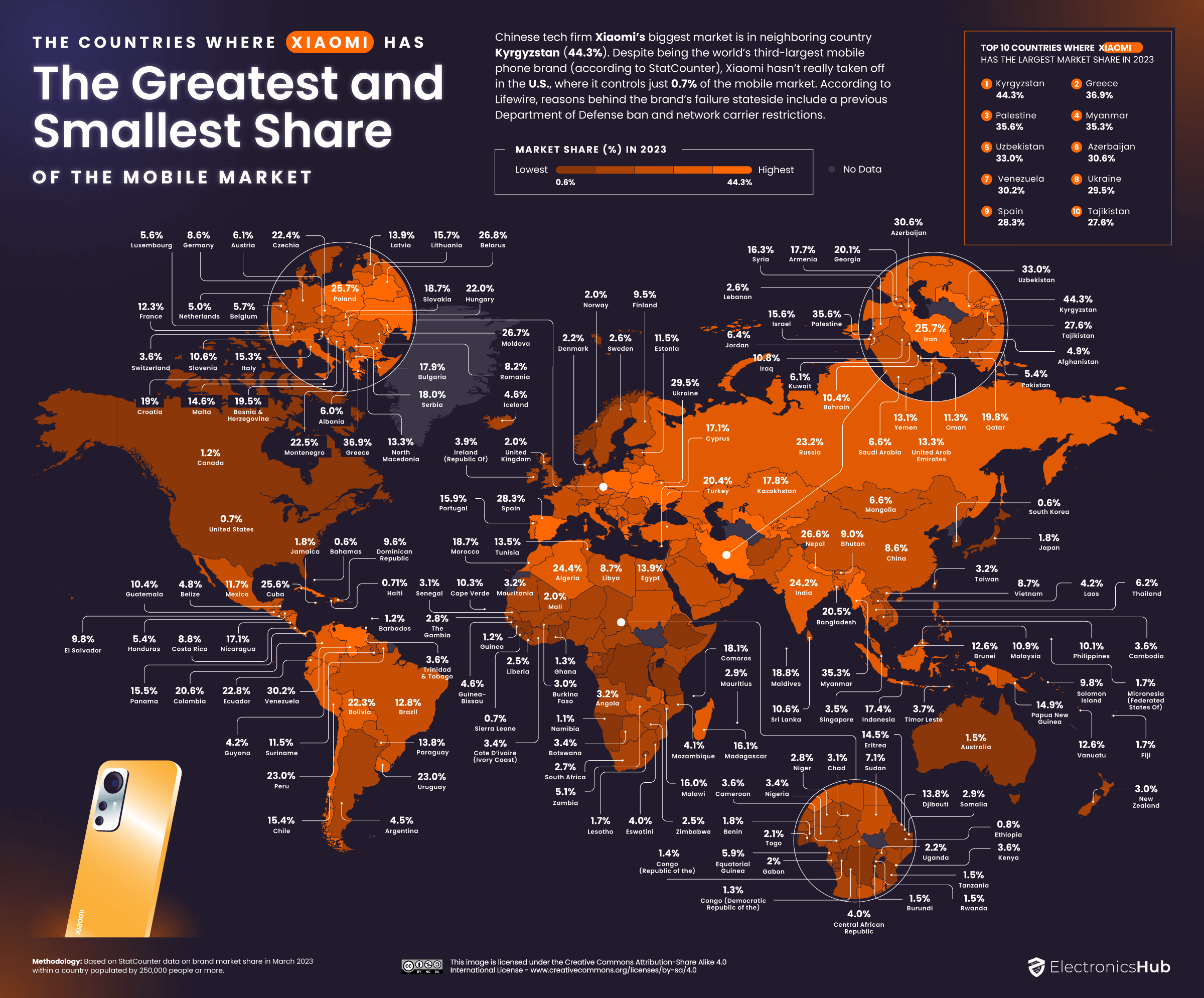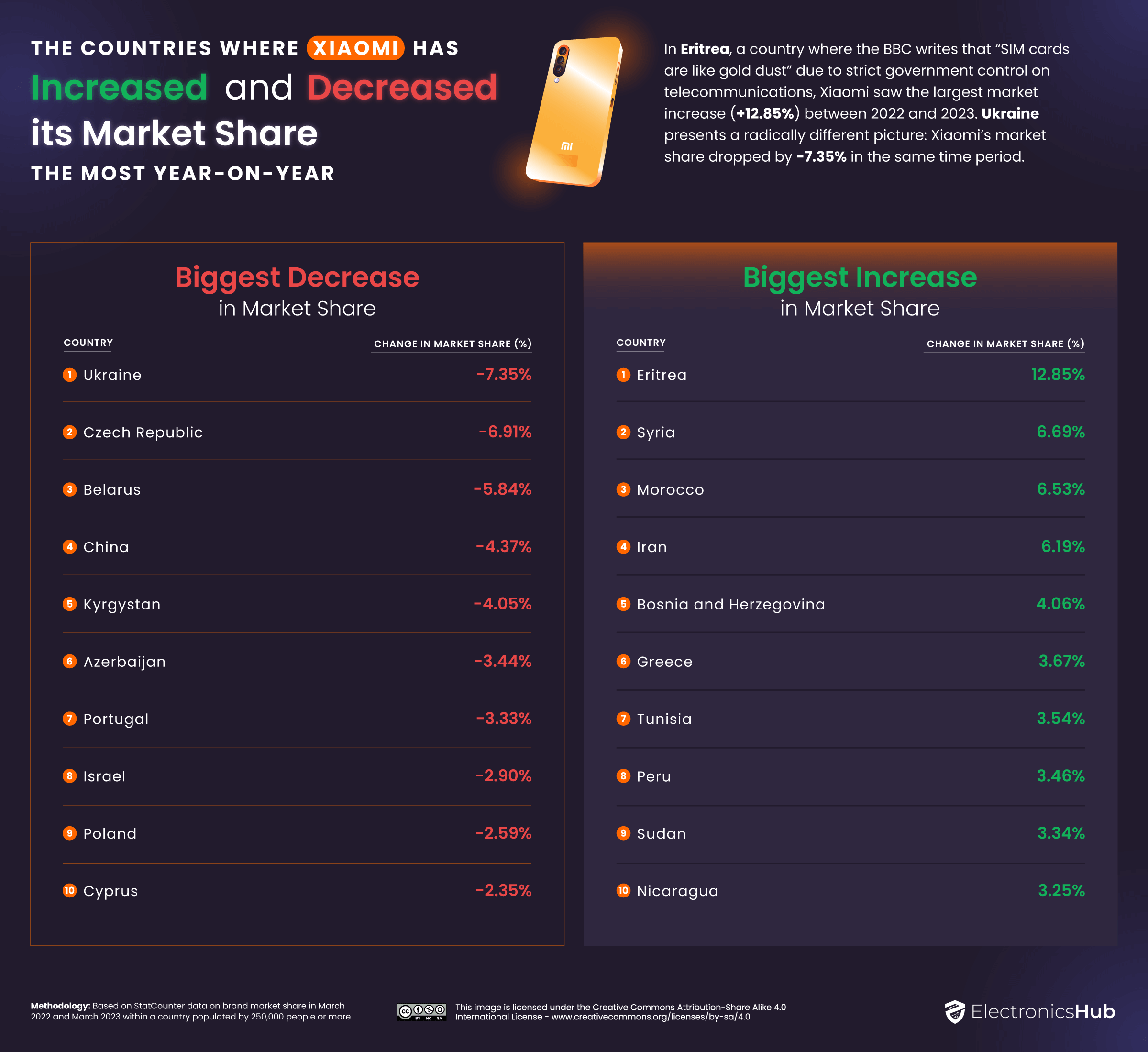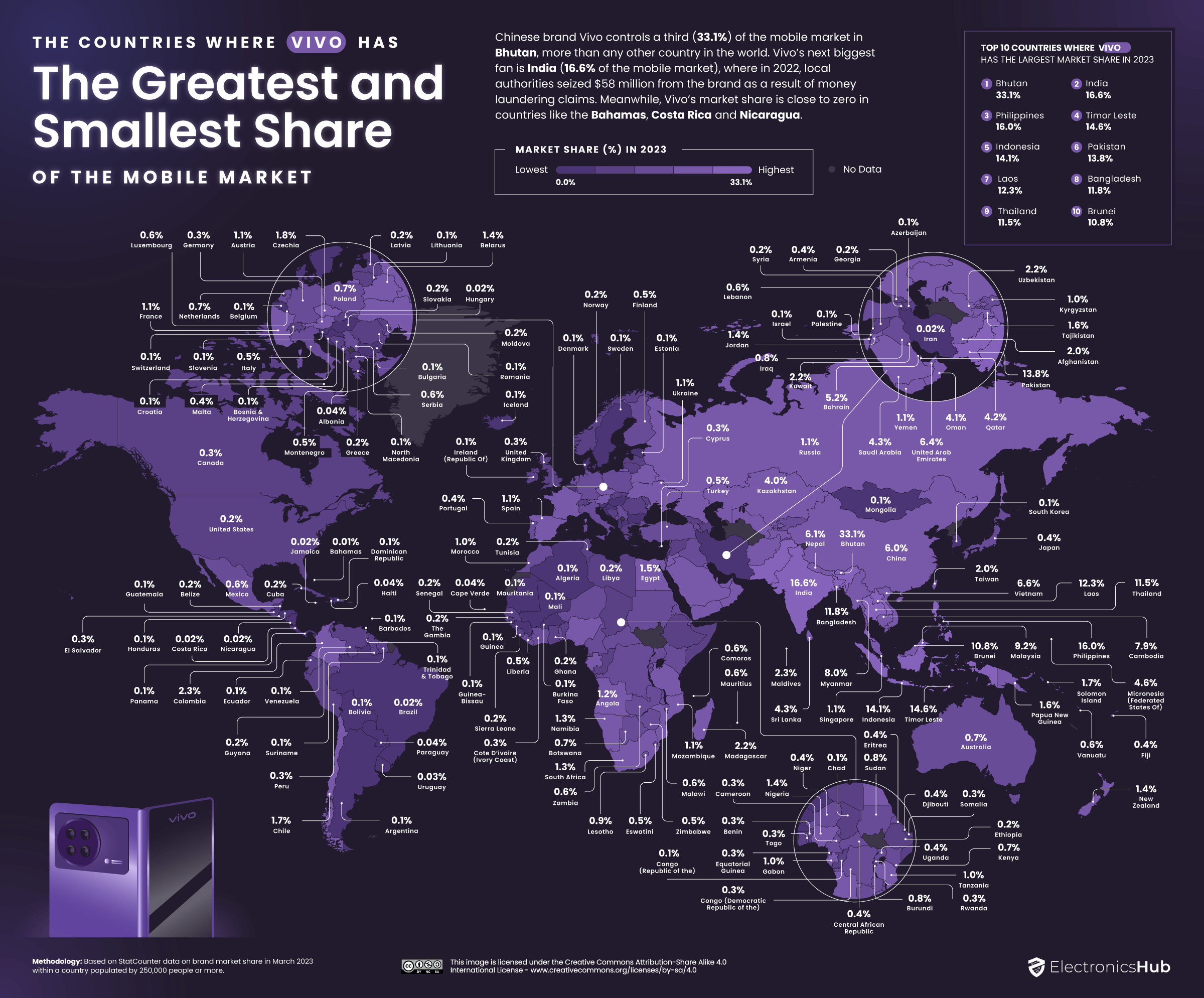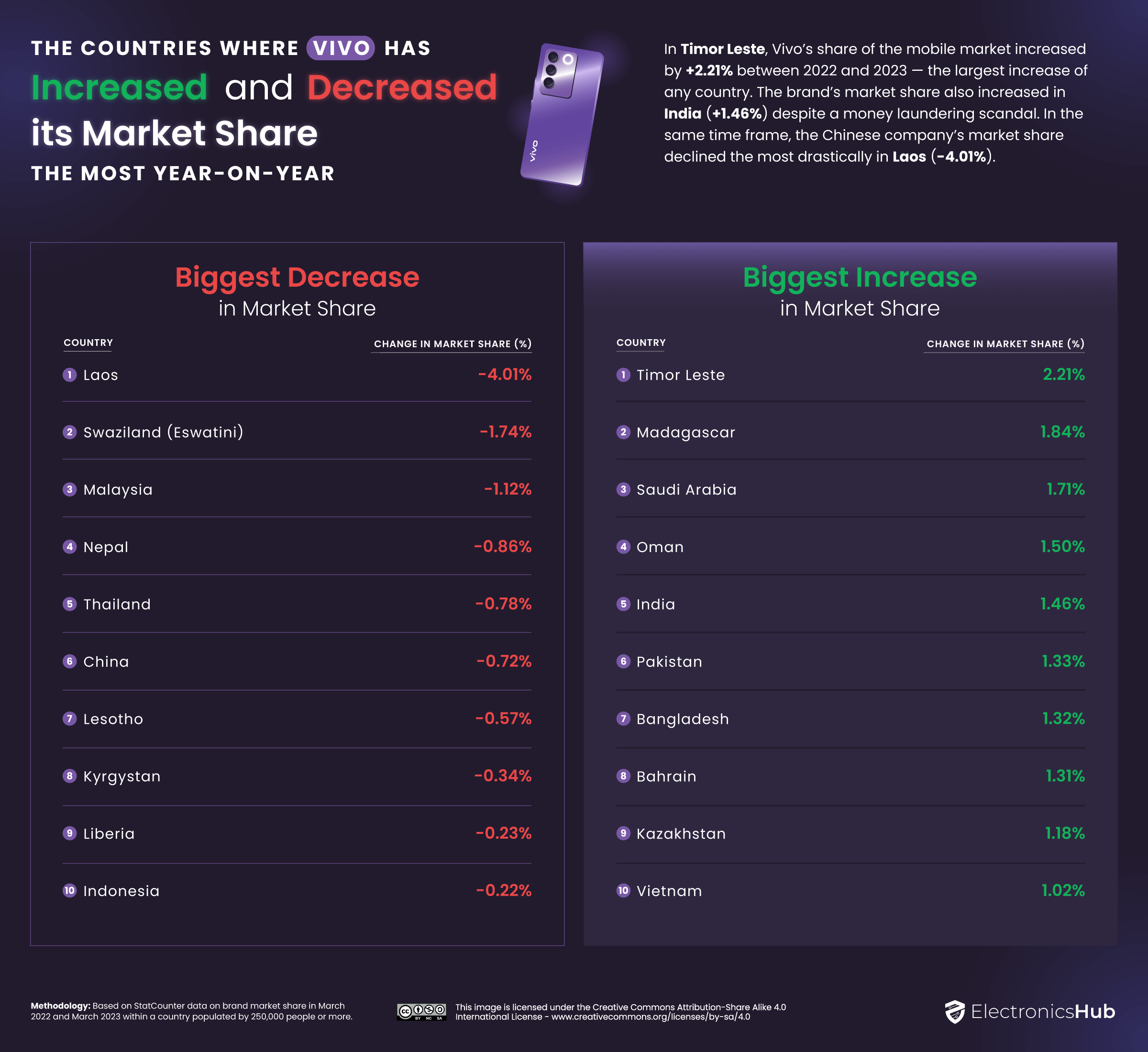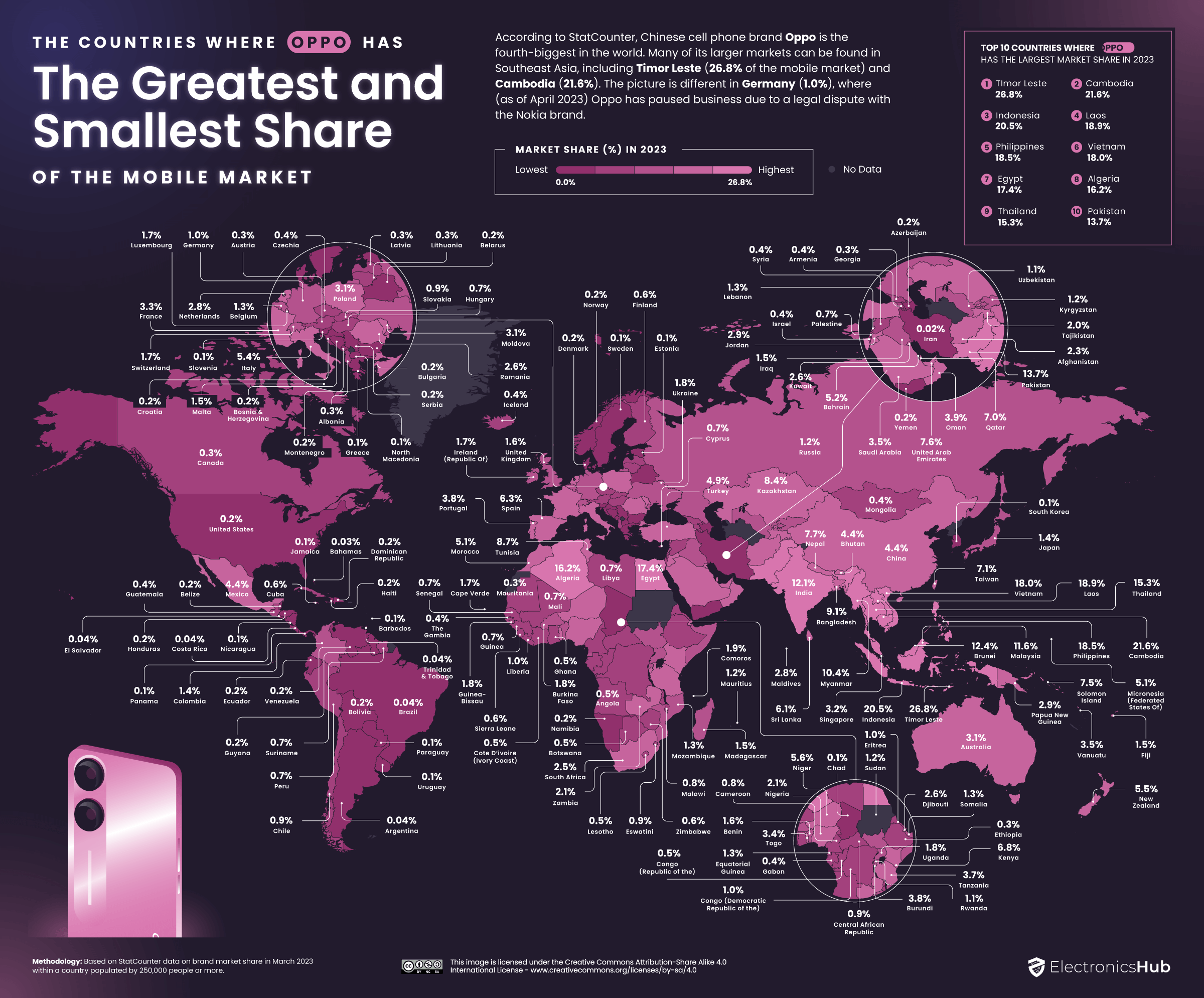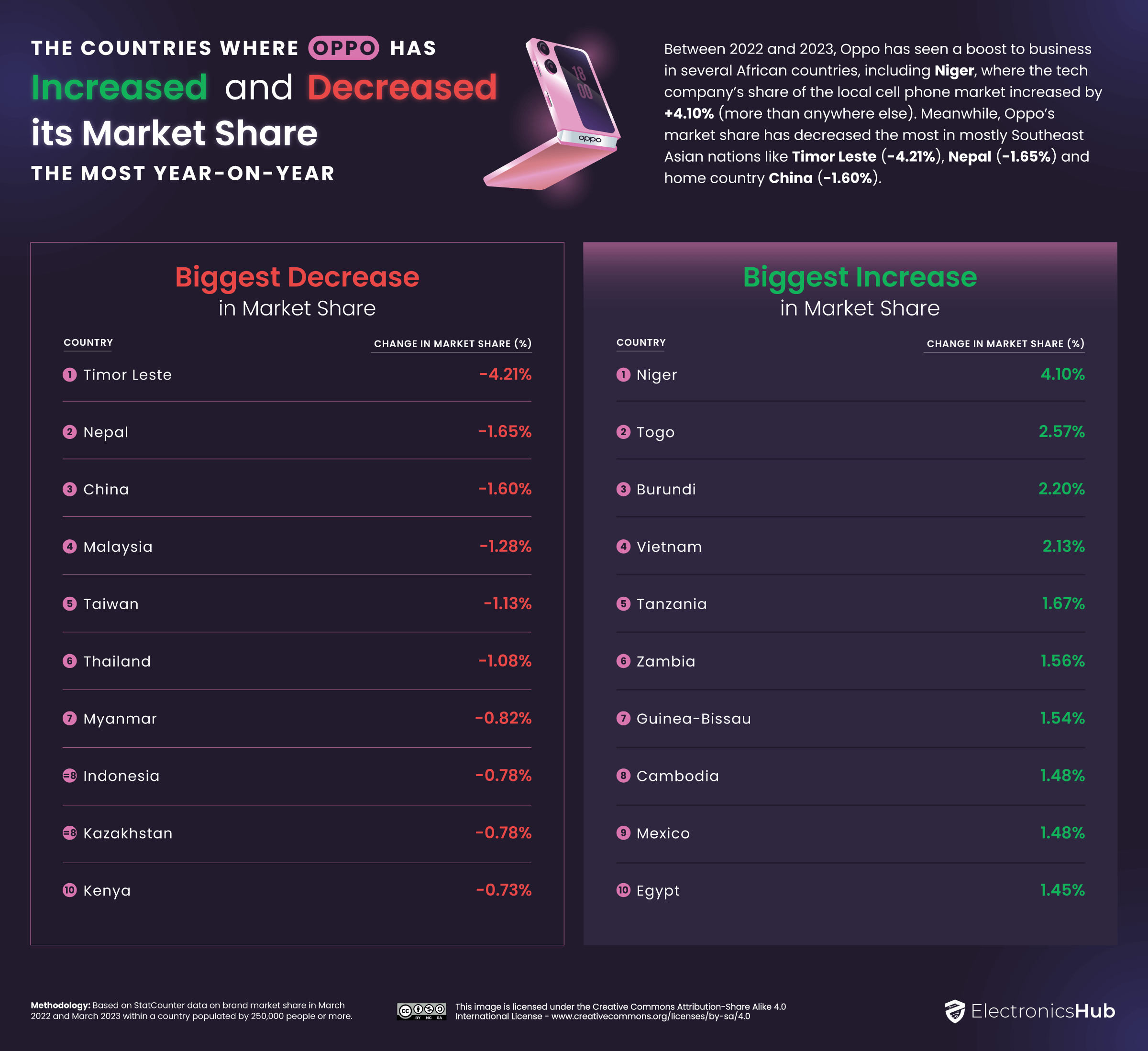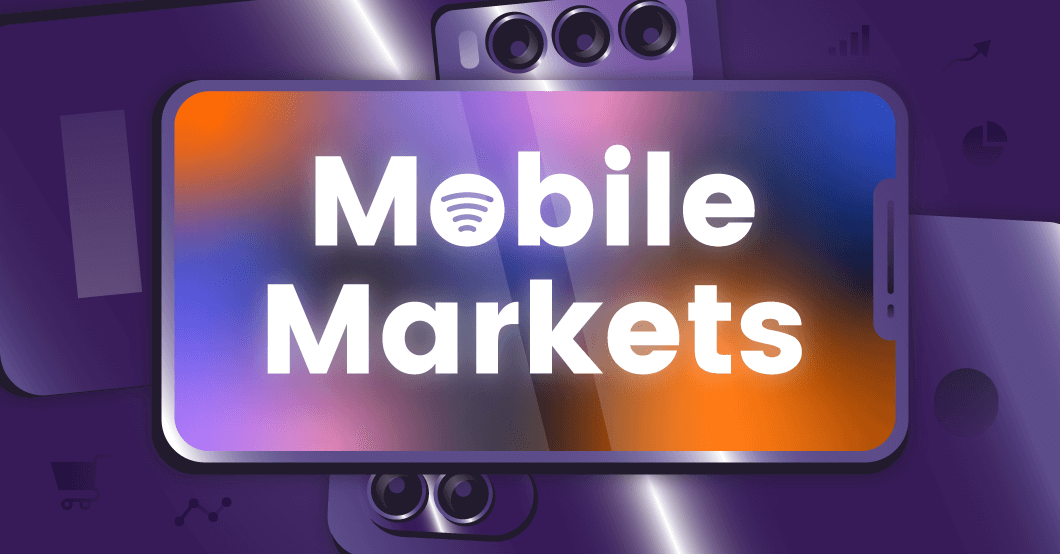
Cell phones have truly taken over. As of 2023, 7.3 billion people around the world use a mobile phone, and 85% of Americans own a smartphone. While the basic functions of the smartphone — making calls, accessing the internet, snapping selfies — are the same for every user, there are countless models on the market that consumers at some point have to choose from.
No doubt affordability is the deciding factor for lots of people, but other shoppers might carefully research features and functions before committing to one cell phone model. You might also be most swayed by a particular phone’s appearance, a factor that a study by the University of Seville found is the most influential when consumers choose a new model.
Brand loyalty also plays a part, something that Apple and Samsung benefit the most from. This got our analysts at Electronics Hub thinking: how popular are different mobile phone brands around the world? We delved into industry data to discover which cell phone brands dominate the market in 171 countries and where in the world their popularity has fluctuated the most in the past year.
Outline
Toggle- What We Did
- Samsung Controls the Mobile Phone Market in More Countries Than Apple
- Fiji Loves Samsung, but China Is Happy Without It
- Samsung Has Seen Lithuanian Market Increase More Than Anywhere Else
- Japan Loves Apple’s Cell Phones
- Apple Increases Control of European Markets
- Xiaomi Nowhere to Be Seen in the United States
- The Market for Xiaomi in Ukraine Has Soured
- Vivo Is Popular in Bhutan but Banned in Germany
- Despite Controversy, Vivo’s Market Share in India Has Increased
- Oppo Flourishes in Southeast Asia
- Africa Embraces Oppo Mobile Phones
- Whatever the Brand, Save Your Cell Phone From the Landfill
- How We Did It
What We Did
We used StatCounter data to find out which mobile phone brands control the biggest share of the market in each country and in which countries a particular brand’s market share has increased and decreased the most between 2022 and 2023.
KEY FINDINGS
- Samsung is the leading mobile phone brand in 95 countries (more than any other brand) and claims the biggest market share (74%) in Fiji.
- Apple dominates in 51 countries and controls the biggest market share (69.79%) in Japan.
- Meanwhile, Chinese brands Tecno, Vivo, Xiaomi, Oppo and Huawei dominate in 25 other countries.
Samsung Controls the Mobile Phone Market in More Countries Than Apple
Which brand is your cell phone? If you’d have said Samsung, you’re in good company: the South Korean firm controls the largest share of the mobile phone market in 95 countries — many more than the leading competitor Apple (top in 51 countries).
Click here to see the image in full size
In 2009, the relationship between the two tech behemoths soured when Samsung released its first Android smartphone, transforming the brand from Apple’s supplier into a fierce competitor. But Samsung and Apple aren’t the only names in the business; elsewhere in the world, the Chinese brands Tecno, Vivo, Xiaomi, Oppo and Huawei claim the biggest share of the local market. Interestingly, Apple dominates in China itself, where iPhones are something of a status symbol.
Fiji Loves Samsung, but China Is Happy Without It
We know that most of the world loves Samsung — but where in particular does the brand dominate?Among the countries where Samsung claims the biggest share of the local market are Fiji (74%), where the brand is helping to bring tech interest into schools, Somalia (71.89%) and Guyana (64.72%). South Koreans are also big fans of the homegrown brand (60.10% of the market).
Click here to see the image in full size
Meanwhile, China places at the other end of the scale: only 1.78% of the local cell phone market is controlled by Samsung (less than anywhere else in the world). Samsung has been “dethroned” in China by homegrown competitors in recent years, not helped by an exploding phone scandal that rocked the brand’s image locally.
Samsung Has Seen Lithuanian Market Increase More Than Anywhere Else
Between 2022 and 2023, Samsung saw the biggest increase in market share in Lithuania (+8.24%), where, in late 2021, the Defense Ministry urged citizens to throw away their Chinese-origin cell phones over security concerns. It could be that the South Korean brand Samsung benefited from these warnings, aptly put by the country’s Deputy Defense Minister: “Our recommendation is to not buy new Chinese phones, and to get rid of those already purchased as fast as reasonably possible.”
Click here to see the image in full size
In contrast, Samsung’s control of the cell phone market has dropped the most in Mauritania (-14.29%). It’s not all been smooth sailing for the brand in recent months, thanks to a major data leak as a result of employees using the AI program ChatGPT to help fix coding problems.
Japan Loves Apple’s Cell Phones
Apple is a behemoth in the world of smartphones, but nowhere is it more popular than Japan, where the American brand claims 69.79% of the local cell phone market. According to Apple Magazine, factors behind Apple’s popularity in Japan include aggressive marketing campaigns, desirable iPhone features and a pervading anti-Korean sentiment that sees local consumers shun the Samsung brand.
Click here to see the image in full size
In a world where iPhones are often the most expensive model on store shelves, it likely also helps that iPhones are the cheapest to buy in Japan. Speaking of the cost, it tracks that Apple claims the lion’s share of the market in wealthier countries like Denmark (67.49%), Norway (65.21%), Canada (62.95%), the United States (59.89%) and Switzerland (58.24%).
Apple Increases Control of European Markets
Led by Belarus (+19.04%), the top ten countries where Apple’s market share increased the most between 2022 and 2023 are mostly in Europe, where the tech firm has invested €85 billion in local suppliers over the past five years and “supports more than 2.6 million jobs.”
Click here to see the image in full size
But being a mega-famous brand the world over doesn’t mean your popularity won’t ebb and flow on a local level; Apple’s hold of the market decreased in several countries between 2022 and 2023, led by Greece (-4.64%). The tech giant’s sales faltered at the beginning of 2023, and the worldwide cost of living crisis could be to blame; the BBC writes that “buyers, squeezed by rising prices, [have] put off purchases of computers and iPads.”
Xiaomi Nowhere to Be Seen in the United States
Among the countries where Chinese brand Xiaomi claims the biggest share of the local cell phone market are Kyrgyzstan (44.33%), Greece (36.86%), and Palestine (35.57%). The first European country in which the brand launched was Spain, which also ranks in the top 10 for the brand’s market share at 28.34%. In contrast, if you’re based in the U.S. and you’ve not heard of this brand before, that’s likely because it controls less than one percent of the market there.
Click here to see the image in full size
For one thing, Xiaomi was the target of a (now lifted) blacklisting by the Trump administration. The brand also doesn’t want to play by carrier network rules stateside; in Hugo Barra’s (Xiaomi’s ex-global VP) own words: “Brands need a carrier partnership to make inroads in the U.S., and Xiaomi isn’t willing to do that.”
The Market for Xiaomi in Ukraine Has Soured
Between 2022 and 2023, Xiaomi’s control of the Eritrean market increased by 12.85% — more than anywhere else in the world. In contrast, Xiaomi’s share of the market dropped the most (-7.35%) in Ukraine, perhaps as a result of the brand being labeled an “international sponsor of war” by Ukraine’s National Agency on Corruption Prevention.
Click here to see the image in full size
Chinese telecoms brands like Xiaomi have been the target of bans and restrictions in recent years because of security concerns. In November 2022, the U.S. officially banned the import of certain Chinese telecom equipment “deemed to pose an unacceptable risk to national security.” Over in Europe, the European Union is urging more countries to ban Huawei and other Chinese telecom brands from using 5G networks.
Vivo Is Popular in Bhutan but Banned in Germany
The Chinese tech brand Vivo claims large shares of the cell phone market in several Southeast Asian countries, led by Bhutan (33.10%). Indonesia (14.07%)is also a big fan, and according to analyst Risky Febrian, it’s partly because the brand offers “several configurations or models specifically for Indonesian consumers.”
Click here to see the image in full size
Elsewhere, Vivo isn’t such a big name. The brand claims a minuscule 0.34% share of the market in Germany, which is likely to decline even further thanks to a total ban as a result of a patent dispute with Nokia.
Despite Controversy, Vivo’s Market Share in India Has Increased
Between 2022 and 2023, Vivo saw its hold on the cell phone market in India increase by 1.46%, the fifth-highest rate in the world. Despite a major money laundering scandal, Vivo shows no signs of slowing down in India, with plans set to increase manufacturing locally.
Click here to see the image in full size
Meanwhile, Laos (-4.01%), Eswatini (-1.74%) and Malaysia (-1.12%) all rank among the countries where the brand’s market share has decreased the most in the same time frame.
Oppo Flourishes in Southeast Asia
Chinese brand Oppo claims huge shares of the local cell phone markets in certain Southeast Asian countries, among them Timor Leste (26.79%) Cambodia (21.63%), Indonesia (20.45%), Laos (18.93%), the Philippines (18.47%) and Vietnam (17.95%).
Click here to see the image in full size
According to the South China Morning Post, Oppo and other “deep-pocketed” Chinese phone brands are flourishing in the region thanks to aggressive marketing tactics and low handset costs.
Africa Embraces Oppo Mobile Phones
Seven of the top 10 countries in which Oppo has seen the biggest market share increase between 2022 and 2023 are in Africa, led by Niger (+4.10%). It seems affordable, high-performance Chinese smartphones (like Oppo’s) are providing a boost to the continent’s digital economy.
Click here to see the image in full size
As former journalist and content creator Ali Muslim puts it, “[there’s] no doubt that Chinese smartphone brands have offered people like us a lifeline in content creation … with less than $200, you can acquire a good smartphone with better cameras that we can use to make videos for our online followers.”
Whatever the Brand, Save Your Cell Phone From the Landfill
With so many phones and brands on the market, all clamoring to offer you new and improved features, throwing away your phone and upgrading to a sleek new model can be tempting — but as we detailed back in January, e-waste (electronic waste) in the world today is a very big problem. For example, in just a single day, humans produce 140,000 metric tons of electronic waste (including cell phones and computers), which we visualize as a pile of trashed tech equivalent to the Taj Mahal.
If you’re well and truly set on getting rid of your cell phone, there are a fair few places in the U.S. you can take your phone to be recycled. If there’s still life in it yet but it’s on the fritz, you might want to take it to a local Repair Café or try your hand at fixing it yourself — let’s just hope it’s one of the easiest models on the market to fix!
How We Did It
We discovered which mobile brand has the biggest market share in every country with a population of 250,000 people or more.
Our results consider the market shares within countries during March 2022 and March 2023. All figures on mobile market shares per country were sourced from StatCounter. This website tracks 5 billion page views per month across its network of 1.5 million sites, monitoring the data revealed about the nature of the visitors. This provides, among other things, a breakdown of the mobile brands used by visitors from each country, year-on-year.
The mobile brand with the biggest market share is correct for March 2023, and the change in market share of mobile brands considers the change in market share between March 2022 and March 2023.
This analysis is correct as of July 2023.

